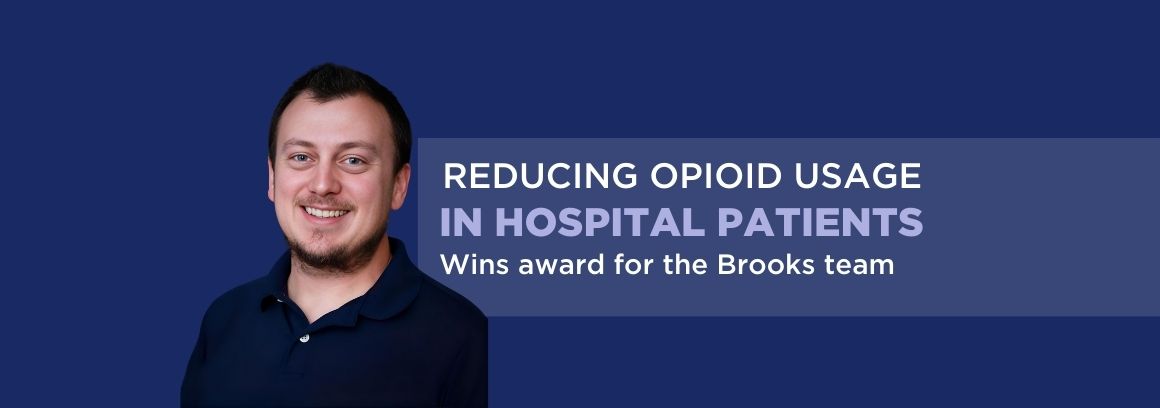Reducing Opioid Usage of Hospital Patients Wins International Award for the Brooks Team

Back to physical health resource hub
The opioid epidemic has long been a public health crisis, characterized by the widespread misuse and addiction to opioids, including prescription painkillers and illegal substances.
To address this issue, physicians have been tasked with limiting the duration and dosage of opioid prescriptions and exploring alternative pain management options.
In an effort to track and reduce opioid usage at its inpatient hospitals Parag Shah, MD, MBA, FACHE, medical director of Brooks Rehabilitation Hospital – Bartram Campus, recruited the Brooks data solutions team to help physicians track the usage in patients.
“The physician has to be the one who takes ownership, being held to higher standards and understanding patient safety,” said Dr. Shah. “In the context of opioids, how can we track usage effectively or what is the best way to track it? And then by having an effective way to track it, how can you reduce its use?”
Tackling the Opioid Reduction Project
The project goal was to effectively track and monitor opioid administration among patients admitted to an inpatient healthcare facility at Brooks.
 Mindi Manes, PhD, director of the Brooks Center for Outcomes Analytics and Research (COAR), was one of the members of the team tasked to answer that question.
Mindi Manes, PhD, director of the Brooks Center for Outcomes Analytics and Research (COAR), was one of the members of the team tasked to answer that question.
“This was a very big undertaking,” said Dr. Manes. “The data, research and clinical teams collaborated at every step of the way to ensure the dashboard was validated and presented in the way physicians would be able to use it to inform their clinical decisions.”
This was new ground for the Brooks team, as there was limited guidance on how to effectively track and aggregate opioid administration among patients admitted to an inpatient healthcare facility. The entire Brooks data solutions team, made up of data management, integration and analytics were all highly involved in this project.
According to Mathew Raters, data analyst at Brooks and integral to building the project in SaS, understanding what data the physicians wanted was key in making this project successful. “We needed to track opioid usage at admission compared to discharge and their overall net  decrease. We worked with the physicians to see how they wanted to view the data.”
decrease. We worked with the physicians to see how they wanted to view the data.”
SAS (Statistical Analysis System) is a prominent software company known for its analytics and data management solutions. The software is widely used to analyze large datasets, derive insights and make data-driven decisions.
The Brooks teams employed SAS tools and a multi-faceted data strategy. They extracted data from the Brooks electronic medical records (EMR) and used the SAS Enterprise Guide to standardize opioid dosages. This standardization was an important point.
“We generated morphine milligram equivalents (MMEs),” said Dr. Shah. “There are different prescribed opioids, such as codeine, hydrocodone, oxycodone, fentanyl – to name a few. We converted them all to morphine with milligram equivalents. So, for the project’s purposes, we were comparing apples to apples across the board.”
The team used SAS Visual Analytics to create an interactive dashboard to visualize trends in opioid administration and alert healthcare teams. Additionally, they used the SAS Enterprise Guide to automate daily email notifications to physicians.
“We found that the dashboard we created was very useful, but physicians are on the go so they needed an option that they could easily access,” said Raters. “We developed the email process so physicians received timely data for their rounds every day and could make real-time changes when needed.”
Impressive Results
The SAS Visual Analytics dashboard became a vital part of the clinicians’ pain management discussions and contributed significantly to opioid reduction. The teams compared the six months before and after implementing the tool and saw a substantial reduction in opioid administration, with physicians actively using the email alerts for better patient care.
“Opioid use is trending down,” said Dr. Shah. “Physicians are looking at other non-opioid options for managing pain. It could be simple things like heat, ice, stretching, other medications, other modalities. That’s what the team and the physicians are doing – how can we manage pain other than with opioids? That’s part of the reason we’re seeing the reduction.”
Dr. Shah presented the project at a recent American Medical Rehabilitation Providers Association (AMRPA) meeting, raising awareness and getting some great feedback from other physicians on how it would be helpful to them.

“This project highlights the importance of using data to generate knowledge to inform practice,” said Dr. Manes. “And that’s where healthcare organizations really need to be going – and a lot of them are. It can’t just be the data team or clinical team or research team. Everybody needs to work together on projects like these to get the best results and improve patient outcomes and care.”
International Award Recognition
On behalf of the Brooks teams, Mathew Raters submitted the opioid project to the 2023 SAS Customer Recognition Awards, which “recognize customers and partners for their standout contributions over the past year.” The Brooks entry was in the international and highly competitive “Innovative Problem Solver” category whose 20 entrants included heavy hitters like Delta Airlines, T-Mobile, and CNO Financial Group. The Brooks project took 2nd place.
“It speaks to the judging panel really finding value in what we are doing,” said Raters. “It speaks highly of Brooks, our project and the way we think. We like to approach all of our problems like this. We want to affect change, in real-time, and for it to be valuable to the patient, provider and community. I think it’s great recognition for us and a great achievement.”


